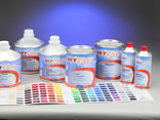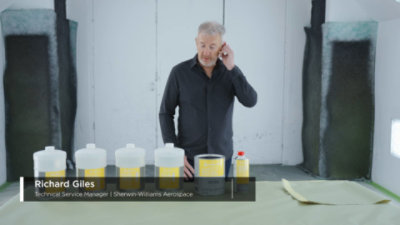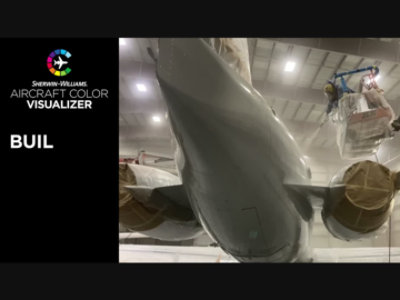WEBVTT
00:08.299 --> 00:09.384
I'm very proud to
00:09.384 --> 00:12.387
announce a new product
to our aerospace division.
00:13.221 --> 00:16.224
This is a conductive coating.
00:16.433 --> 00:19.394
What is a conductive coating on airplanes?
00:19.394 --> 00:23.356
These are applied strategically depending
on the model of the aircraft.
00:24.315 --> 00:25.900
On the radome, for example.
00:25.900 --> 00:27.152
Wingtip body fairing.
00:27.152 --> 00:30.155
Some miscellaneous areas.
00:30.280 --> 00:32.907
It's all in the imam. It's all on drawing.
00:32.907 --> 00:35.910
It will tell you exactly where
to place these materials.
00:35.994 --> 00:38.121
This one is a 1 to 1 ratio.
00:38.121 --> 00:39.372
Of course it's black.
00:39.372 --> 00:42.333
Being a conductor coating,
00:42.333 --> 00:44.127
it can be used with any spray equipment.
00:44.127 --> 00:46.755
Comes to mind not estate.
00:46.755 --> 00:49.758
This is conventional spray equipment.
00:50.592 --> 00:52.969
Once this material is dry,
00:52.969 --> 00:55.430
any primer topcoat system
00:55.430 --> 00:58.433
may be applied on top of this material.
01:02.395 --> 01:05.440
This is strategically placed on aircraft,
01:05.648 --> 01:08.526
and it could vary my make model.
01:08.526 --> 01:11.529
Different areas are applied,
and conductive coating
01:11.696 --> 01:14.783
must or usually goes on top of a primer
on top of a surface,
01:14.783 --> 01:18.703
on top of something,
and it's usually a composite material.
01:20.830 --> 01:22.373
The application of this
01:22.373 --> 01:26.252
is one singular, one cross coat,
depending on how you apply this.
01:26.586 --> 01:28.838
Just not to fully hide.
01:28.838 --> 01:31.216
It has to be insulated to the background
itself.
01:31.216 --> 01:33.176
Reclose film.
01:33.176 --> 01:35.470
And then you can apply
01:35.470 --> 01:38.556
a very thin coat of primer
on top of that to tone down the block.
01:39.182 --> 01:42.185
I'll go straight to top coat
depending on what the top coat color is.
01:42.811 --> 01:45.021
So I'm going to be mixing this
01:45.021 --> 01:48.024
and apply it over the primer.
01:48.149 --> 01:51.027
Okay. Top tip. Mixing.
01:51.027 --> 01:53.113
Again it's very important
that if you're scooping out
01:53.113 --> 01:54.989
the can you keep the lid clean.
01:54.989 --> 01:58.827
Make sure that the channels right
so you can press down for future use.
01:59.619 --> 02:03.915
If you leave the lid open, the shelf life,
obviously solvent evaporates.
02:03.915 --> 02:06.251
It leads to debris in the can.
02:07.502 --> 02:09.003
What we normally do
02:09.003 --> 02:12.549
is we take a relevant sized, clear glass,
02:13.800 --> 02:16.177
beaker and I pre mark them.
02:16.177 --> 02:18.346
Essentially this for accurate mixing.
02:18.346 --> 02:21.307
What I'm going to be doing in this case
I'm going to be scooping with a,
02:22.350 --> 02:23.351
a cup.
02:23.351 --> 02:25.895
Make sure it's the non mox design
02:25.895 --> 02:29.023
so that, it doesn't melt and disrupt
the finish.
02:29.649 --> 02:32.652
So we're going to just take the cup here.
02:37.991 --> 02:39.284
Okay.
02:39.284 --> 02:42.245
We're now 200 mills in this case.
02:46.749 --> 02:49.752
And on this big mouth can.
02:50.962 --> 02:53.965
Which is generally very easy to pour out.
02:58.845 --> 03:00.763
We're going to dispense.
03:00.763 --> 03:03.766
And the reason I do this
to keep everything clean,
03:04.726 --> 03:07.645
decanting into a small one, into
the container is better than trying
03:07.645 --> 03:12.066
to slosh into this particular
when you're doing parts of a gallon.
03:12.817 --> 03:16.070
So it's to keep things
clean, emphasizing, guys,
03:17.447 --> 03:19.782
the kitchen is everything.
03:19.782 --> 03:21.701
If you get this wrong,
03:21.701 --> 03:24.704
then it falls down from there.
03:25.622 --> 03:26.789
So here we are.
03:26.789 --> 03:29.792
We're now at a 1 to 1 ratio.
03:30.877 --> 03:33.880
The material is very thin.
03:35.256 --> 03:37.508
As we can see,
everything is stirred and stirred.
03:37.508 --> 03:40.511
Well, pretty shaken base, obviously.
03:41.429 --> 03:44.265
So it's very, very thin.
03:44.265 --> 03:47.227
This is a working product.
03:49.646 --> 03:52.857
So once you've got a nice dispersion here,
03:53.274 --> 03:56.527
you can feel it actually on the stick
when it's all one
03:58.321 --> 04:01.324
will place it into the.
04:07.747 --> 04:09.165
And then dispose of anything
04:09.165 --> 04:12.126
that is of no value. Now.
04:15.129 --> 04:15.463
Again
04:15.463 --> 04:18.466
if you're doing components
what I would encourage
04:18.967 --> 04:19.509
that. You're right.
04:19.509 --> 04:22.303
The mixing time, the activation time down.
04:22.303 --> 04:23.805
That's when you know it's still in life.
04:23.805 --> 04:25.598
Good. It has a good port life.
04:25.598 --> 04:28.268
You still need to know
if you're on the production shop
04:28.268 --> 04:30.770
doing various components.
04:30.770 --> 04:32.438
You're not sure when you mixed it.
04:32.438 --> 04:35.525
So you have to remember
when it could be in an airport line
04:37.193 --> 04:39.988
going back on the can.
04:39.988 --> 04:41.739
We'll use a
04:41.739 --> 04:45.910
a composite mallet just to squish it down
into the the rim of the can.
04:46.327 --> 04:49.330
And again, that maximizes, shelf life.
04:52.333 --> 04:54.669
As for the guns concerned.
04:54.669 --> 04:56.129
Again
04:56.129 --> 04:57.714
conventional gun.
04:57.714 --> 05:00.758
Typically the air is very strategic
on aircraft.
05:01.426 --> 05:05.596
The areas can be confined to radome
right on body fairings.
05:05.972 --> 05:09.475
Certain areas of the aircraft
which are specific for that frame
05:10.476 --> 05:13.479
and as mentioned earlier
it can be in the air.
05:13.646 --> 05:16.482
Or it can be on
drawing a schematic drawing.
05:16.482 --> 05:19.485
And that will tell you
where to apply this material.
05:19.944 --> 05:22.322
So here we are. And let's get going.














